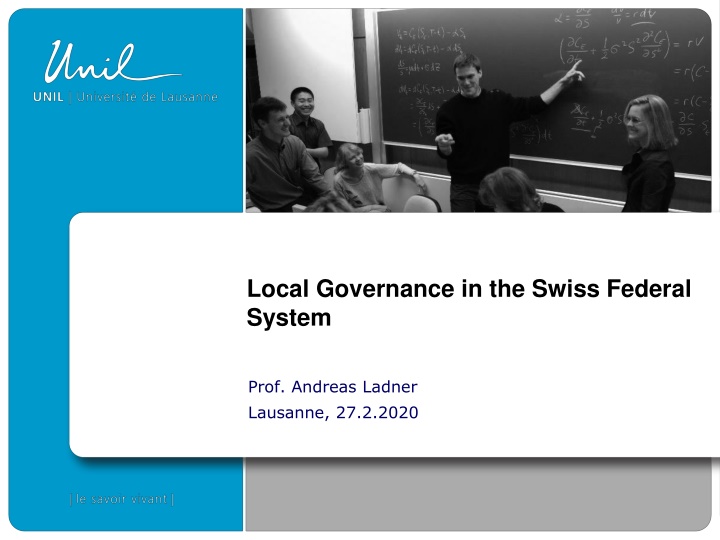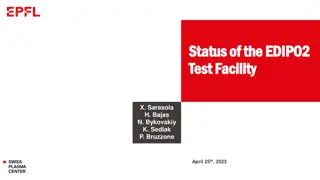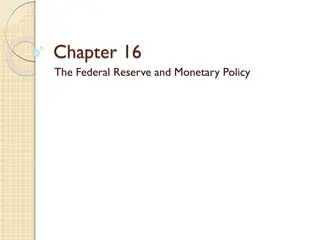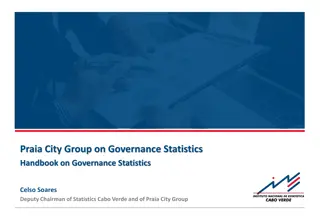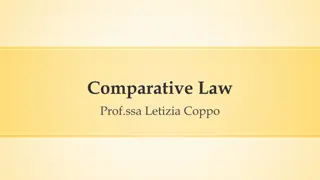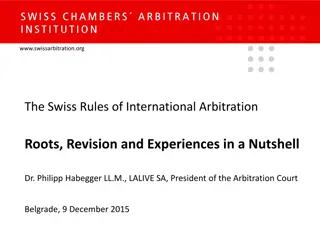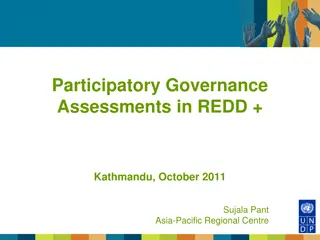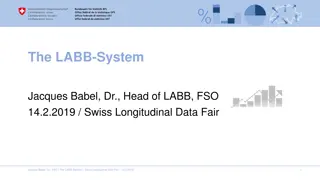Local Governance in the Swiss Federal System
The Swiss federal system comprises 26 cantons and over 2,200 municipalities, each with significant autonomy and diverse structures. With a population of 8.2 million, Switzerland's local governance system emphasizes competition and solidarity among its federal units. Cantons enjoy far-reaching competences, financial resources, and decision-making powers without overarching political control.
Download Presentation

Please find below an Image/Link to download the presentation.
The content on the website is provided AS IS for your information and personal use only. It may not be sold, licensed, or shared on other websites without obtaining consent from the author.If you encounter any issues during the download, it is possible that the publisher has removed the file from their server.
You are allowed to download the files provided on this website for personal or commercial use, subject to the condition that they are used lawfully. All files are the property of their respective owners.
The content on the website is provided AS IS for your information and personal use only. It may not be sold, licensed, or shared on other websites without obtaining consent from the author.
E N D
Presentation Transcript
Local Governance in the Swiss Federal System Prof. Andreas Ladner Lausanne, 27.2.2020
Inhabitants (8,2 million) ZH BE VD AG 1'211'647 943'696 620'294 544'306 BS GR NE SZ 187'667 186'744 165'731 130'232 SG GE LU TI VS BL SO FR TG 449'399 408'820 347'209 310'215 276'170 260'036 244'015 236'339 227'306 ZG SH JU AR GL NW UR OW AI 99'388 73'305 68'794 53'515 38'546 38'000 35'246 32'414 15'021 Quelle: www.badac.ch Quelle: www.badac.ch
Size of municipalities (%) Anteil Gemeinden 25 20 15 10 5 0 10000-19999 20000-49999 50000-99999 1000-1999 2000-4999 5000-9999 250-499 500-999 bis 249 100000 und mehr
Autonomy and diversity instead of equality of living conditions Quelle: Stalder, Kurt (1999). F deralismus und Finanzausgleich. Schriftenreihe der Fachgruppe f r kantonale Finanzfragen. Solothurn: Verlag FkF.
Swiss Federalism: basic characteristics The existence of the cantons is guaranteed The cantons are free to organize themselves internally The cantons elect their own authorities The cantons dispose of far reaching competences The cantons dispose of their own financial resources There is no political control ruling over the cantons The cantons participate equally in the decision making process on federal level
Competition and solidarity between the different federal units Diversity and fiscal autonomy (competition) Equalization of differences on the basis of minimal standards (solidarity)
The ancient political system in Switzerland Source: http://history-switzerland.geschichte-schweiz.ch/swiss-revolution- helvetic-republic-1798.html
French Revolution (1789) The Storming of the Bastille, July 14, 1789
The foundation of the modern national state (1848) Tensions between the liberal Protestant and the Catholic cantons lead to the civil war in 1847 (the Sonderbundskrieg ). After a brief military campaign with federal troops, the Catholics, who had founded a separatist federation, surrender. 1848 The modern Swiss federal state is founded in 1848. Its constitution centralizes and harmonizes numerous areas which were previously the responsibility of the cantons, such as military service, customs, and postal services and coinage. This leads to the creation of a cohesive territory ripe for economic development.
From a Confederation to a Federal State Federalism, the only solution Two chambers (following the US example) Very limited power for the central state Modification of the Constitution have to be accepted by the cantons and the citizens Residual competences in the hand of the cantons ( bottom-up federalism ) -> diversity Equalization of differences
Confederation, cantons and municipalities: the three levels of the state Revenue, expenditures and transfers
22.0 mrd. 2014/ 2013 National gov. rev.: 64.9 mrd. exp.: 64.7 mrd. National tasks: defense, IR, social security _____ Cantonal tasks: education, health, police _____ Local tasks primary school, social assistance , land use, water, waste etc. 29 mrd. 18.3 mrd. 24.7 mrd. Income Tax Cantonal govs. rev.: 82.7 mrd. exp.: 85.0 mrd. 74.1 mrd. 42.3 mrd. TVA 3 mrd. 26.0 mrd. Local govs. rev.: 45.5 mrd. exp.: 46.1 mrd. 37.3 mrd. Citizens 1 Mrd.= 1 000 000 000 Social Security not included (59.8 mrd.) Health systems only partly included
How are the different tasks allocated to the different levels? (Principle of subsidiarity)
National tasks Defence Foreign policy/IR Railway system National Motorways Nuclear power plants Scientific research Etc.
Cantonal tasks Health Education Police Roads Social security . Execution of national policies
Tasks of Swiss municipalities Education: kindergarten, primary school, secondary school Social welfare and health Water, electricity, and traffic Planning and construction, sport and culture Municipal police (fire, roads, and commerce) Naturalisation ( swiss maker ) Internal organization, financial managemet Execution of higher level tasks
Different forms of cooperation National level Cantonal level Dual Federalism Cooperative Federalism
The three components of a public tasks Deciding/regulating Doing/executing Paying/Funding Who/which level does what?
Central-local relations: problems Who pays the fiddler, calls the tune Principal-agent problem Executing and funding without deciding is not very satisfying
Two levels 24 Titre de la pr sentation jeudi 27 f vrier 2025
Three levels 25 Titre de la pr sentation jeudi 27 f vrier 2025
Indicators of local autonomy Institutional depth (ID): The extent to which local government is formally autonomous and can choose the tasks they want to perform. Policy scope (PS): Range of functions (tasks) where local government is effectively involved in the delivery of the services (be it through their own financial resources and/or through their own staff. Effective political discretion (EPD): The extent to which local government has real influence (can decide on service aspects) over these functions. Fiscal autonomy (FA): The extent to which local government can independently tax its population. Financial transfer system (FTS): The proportion of unconditional financial transfers to total financial transfers received by the local government.
Indicators of local autonomy Financial self-reliance (FSR): The proportion of local government revenues derived from own/local sources (taxes, fees, charges). Borrowing autonomy (BA): The extent to which local government can borrow. Organisational autonomy (OA): The extent to which local government is free to decide about its own organisation and electoral system. Legal protection (LP): Existence of constitutional or legal means to assert local autonomy. Administrative supervision (AS): Unobtrusive administrative supervision of local government. Central or regional access (CRA): To what extent local authorities are consulted to influence higher level governments policy-making.
Country Ranking 2014 | Diapositive 30 |
Local autonomy and GDP_PPP | Diapositive 32 |
Local autonomy and corruption | Diapositive 33 |
Local autonomy and democracy | Diapositive 34 |
Local autonomy and happyness | Diapositive 35 |
But Decentralization does not automatically lead to economic success. Both are results of long, continuing and interdependent processes Autonomy goes hand in hand with diversity Diversity needs mechanisms of equalization
Another important relation Citizens/tax payers Local authorities/civil servants
Citzens and Direct Democracy: Landsgemeinde (cantonal level) AI GL
Two different political systems at the local level Baar: 20,266 inhabitants Baar: 20,266 inhabitants Olten: 17,000 inhabitants Olten: 17,000 inhabitants Municipal assembly Municipal assembly Local parliament Local parliament (81.9 % of the municipalities) (81.9 % of the municipalities) (18.1 % of the municipalities) (18.1 % of the municipalities)
Direct Democracy: Referendums and initiatives
The compulsory referendum (obligatorisches Referendum): Changes of the local code (Gemeindeordnung) and important public expenditures have to be brought to a vote. Any expenditures or projects exceeding 10 Mio. sFr. or recurrent expenditures of more than 500'000 sFr. have necessarily to be accepted by the citizens.
The optional referendum (fakultatives Referendum): A (positive) decision of the city's parliament can be questioned with a referendum a) when a majority of the members of parliament decide so during the same session, b) when within 20 days after the official announcement of this decision at least 4000 citizens demand a vote, and c) when within 20 days one third of the members of parliament asks for it (written request).
The popular initiative (Volksinitiative): Within a laps of time of six month 4000 citizens (those entitled to vote) have to sign a request. If this request aims at something which is in the domain of the compulsory referendum, it is put to a vote of the citizens. If it aims at something which is in the domain of the optional referendum, the decision is in the hands of parliament.
An enormous amount of decisions to be taken In his/her politically active life a citizens is asked to decide on between 1600 and 1800 issues.
Thank you for your attention and your participation!
